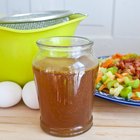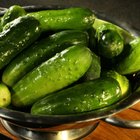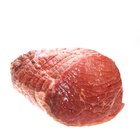
AlexPro9500/iStock/Getty Images
A savory jelly, aspic can be made from a variety of stocks, including veal, pork, chicken, beef and fish. Once chilled, the natural gelatin in the bones sets, forming a clear jelly. Aspic can be eaten on its own, or it can be combined with other ingredients, such as cooked meats, vegetables or sauces. Making aspic at home isn’t difficult, but it requires some technique to suspend any ingredients, as well as ensure that the stock is as clean as possible, which keeps the aspic clear.
Making the Stock
To make the stock for aspic, you need a selection of cleaned bones that have plenty of tendons, also known as cartilage. Knuckle bones or chicken feet are good choices, as they have minimal fat and meat and are rich in tendons that break down during boiling. The tendons are what help aspic solidify, turning into the clear gelatin. Seasoning the stock is key, so herbs, such as thyme and parsley, as well as onion, carrots and celery are often used to flavor the stock. You'll need to boil the stock for several hours.
Clarifying the Stock
To ensure the finished aspic is clear, with no cloudiness or bits of meat or vegetables from the stock, strain the finished stock through cheesecloth a few times to remove any large pieces. To further clarify the stock, beat egg whites into the stock and bring the stock back up to a gentle simmer before straining the stock one last time. The egg whites will cling to any small particles, leaving you with a clear stock. Allow the stock to cool completely, and then remove all of the fat that has solidified at the top.
Setting the Aspic
If your stock does not create a strong enough jelly -- too much water or not enough cartilage -- you may need to add in clear, unflavored gelatin to stiffen the stock. Do so while the stock is still warm, and then chill to test the strength of the aspic. When the consistency is right, mix in any ingredients you need for your aspic -- cooked, chopped meats, cubed vegetables and vegetable juices -- and let it set in the refrigerator overnight. To unmold the finished aspic, carefully dip the aspic container in hot water, and let it sit for two seconds. This melts the outer layer of the aspic, loosening it from the mold and making it easier to remove the aspic without damage.
Using Aspic
Aspic was traditionally used to cover pates, forming a clear, protective coating. It is also the primary ingredient in headcheese, a traditional deli meat commonly eaten in Eastern Europe and Scandinavia. Ideally, aspic should be served thinly sliced, so that when it touches your tongue, the heat from your mouth melts the aspic, creating a warm broth. Aspic is also used to make garnishes and condiments. Mixed with vegetable juices, such as tomato juice, and alcohol and vinegar, aspic makes for a new twist on a traditional pickle. You can serve aspic thinly sliced on crackers, as an entire mold or as sliced cold cuts.
Related Articles

How to Clarify Stock

How to Make Turkey Stock from Leftover ...

How to Make Cucumber Kimchi

How to Reduce Chicken Stock to a Third

How to Make Soup Out of Pulp From ...

How to Make Fish Stock

How to Boil Beef

How to Harden Up Whipped Cream

Potluck Main Dishes That Do Not Need ...

How to Cook a Beef Spleen

How to Get Rid of the Acid Taste in ...

How to Tenderize Gizzards

Vegetarian Substitutes for Chicken Broth

How to Make Merlot Wine

How to Add Noodles to Soup

How to Strain Seeds From Fruit When ...

How to Garnish a Soup

How to Puree Chicken

How to Cook Chinese Lettuce

How to Avoid Bad Breath With a Tongue ...
References
- Joy of Cooking; Irma S. Rombauer
- The Globe and Mail: Aspic Done Right -- Culinary Horror Show No Longer
- Serious Eats: Snapshots from Germany
Writer Bio
Rachel has worked professionally as a chef and writer on food since 2010. In addition to a Bachelor of Arts degree, she holds a diploma in classic culinary arts from the French Culinary Institute. She has an active interest in wine, fine dining and sustainable agriculture.
Photo Credits
AlexPro9500/iStock/Getty Images